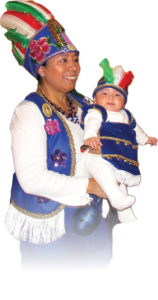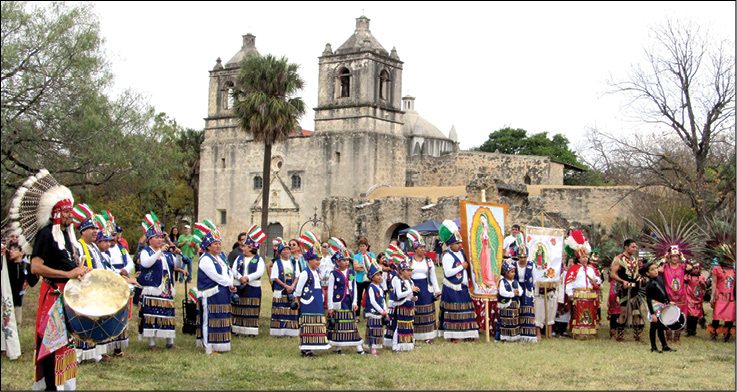[vc_row][vc_column][vc_column_text]BY CAROL BAASS SOWA
TODAY’S CATHOLIC
 SAN ANTONIO • Mission Concepción was once again the site for Danza Matachines on Dec. 3, with 12 troupes of colorfully garbed matachin dancers performing a traditional ritual dance that dates to Spanish colonial times. The event marked the fifth such observance at the mission, with between 350 and 400 participants from throughout the Archdiocese of San Antonio celebrating the upcoming patronal feast of the Immaculate Conception, the mission’s namesake, on Dec. 8, as well as the feast of Our Lady of Guadalupe on Dec. 12.
SAN ANTONIO • Mission Concepción was once again the site for Danza Matachines on Dec. 3, with 12 troupes of colorfully garbed matachin dancers performing a traditional ritual dance that dates to Spanish colonial times. The event marked the fifth such observance at the mission, with between 350 and 400 participants from throughout the Archdiocese of San Antonio celebrating the upcoming patronal feast of the Immaculate Conception, the mission’s namesake, on Dec. 8, as well as the feast of Our Lady of Guadalupe on Dec. 12.
The matachines troupes included: Mission Concepción Matachines; Our Lady of Angels Matachines; Indios Guadalupanas, St. Lawrence Parish; Danza Azteca, Our Lady of Guadalupe Parish, Helotes; Immaculate Heart of Mary Matachines, Pearsall; Sacred Heart Matachines; St. Leo the Great Matachines; Holy Family Matachines; St. Mary Magdalen Matachines #1; St. Mary Magdalen Matachines #2; Danza Guadalupana Iglesia St. Michael; and Los Soldados de la Virgen Guadalupe.
Father David Garcia, pastor at Concepción, welcomed those present in front of the mission, explaining it was a day to ask Mary, the mother of Jesus, to help us say “yes” to what he wants us to do. “We’re here to pray. We’re here to celebrate. And we’re here to be together as a community of faith, so we can honor her and her son,” he related.
He pointed out that the nearby San Antonio River, to which they would make a procession through Concepción Park, was vitally important to the founding of both San Antonio and the mission. Water, he explained, is necessary to sustain life and a gift from God, which is why it is used in baptism to signify our receiving life from him.
Matachines dances developed from efforts by the early Spanish missionaries to incorporate native indigenous music and dance into Catholic celebrations for their native converts. A stock character in the dances is El Viejo, usually portrayed as a fearsome old man with a whip, who seeks to lead people astray. Several of the matachines troupes that day included individual versions of this evil incarnation, who marched beside them in suits adorned with colorful ribbons or strips of cloth, representing sins. Dancers ranged from senior citizens to young children, the littlest matachin being a costumed infant carried in a matachin mother’s arms.
Accompanied by drums, maracas, conch shell horn and recitation of prayers, participants danced in a line that wound around the perimeter of the park, returning to the mission, where each group danced in front of the mission church and then inside it, before the altar and historical portraits of Mary.
The last troupe to enter the church, Los Soldados De La Virgen Guadalupe, featured the dancers turning on their El Viejo, chasing him down the aisle, and forcing him to kneel before the image of Our Lady of Guadalupe, good conquering evil. Father Garcia then invited onlookers to join the matachines in dance before the altar and did so himself, to the delight of all.
Tony Aguilar, organizer of the annual event, noted the feasibility of extending next year’s procession from Mission Concepción to Mission San José is presently in discussion.[/vc_column_text][/vc_column][/vc_row][vc_row][vc_column][vc_single_image image=”10144″ img_size=”large”][/vc_column][/vc_row]


